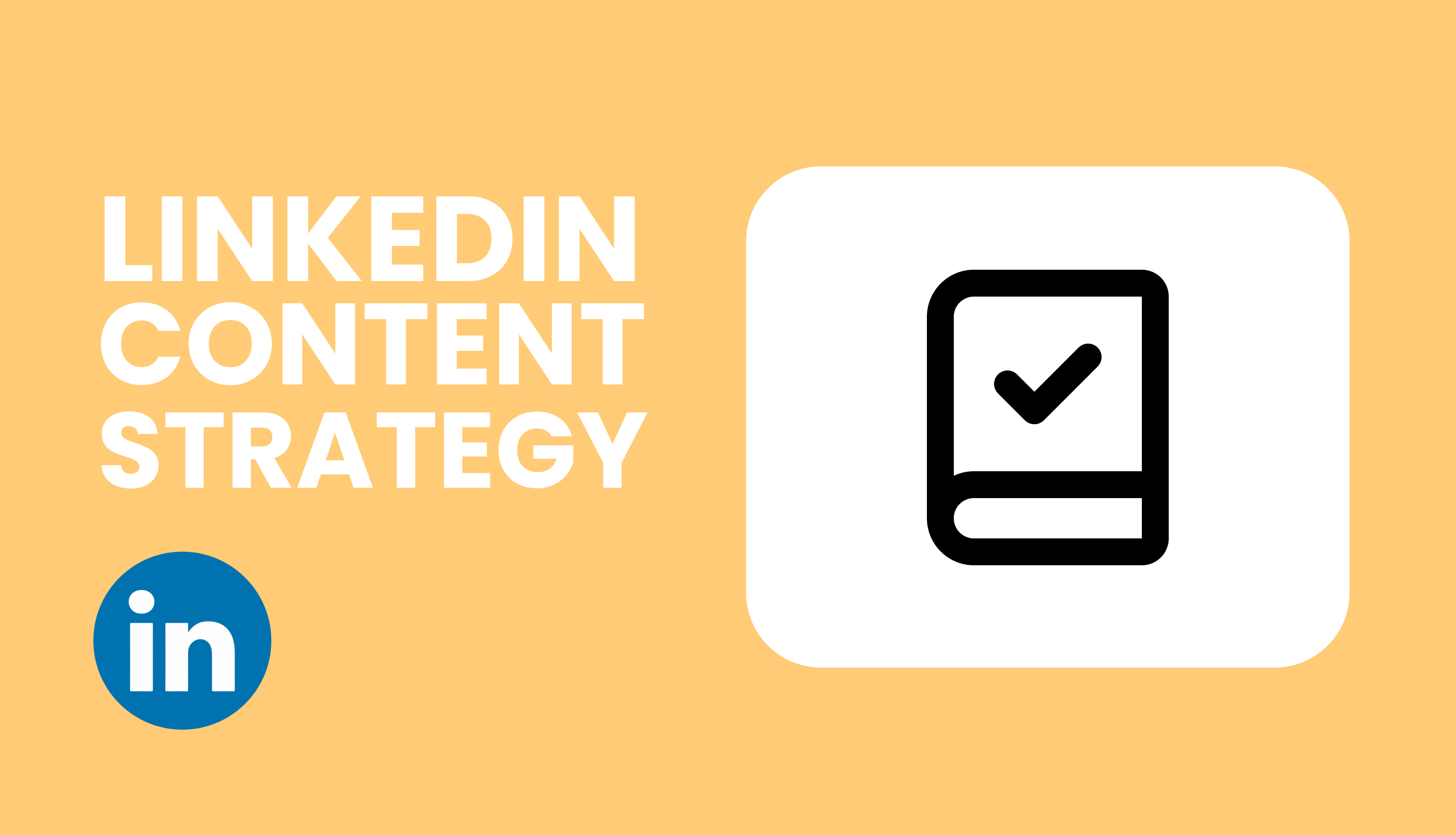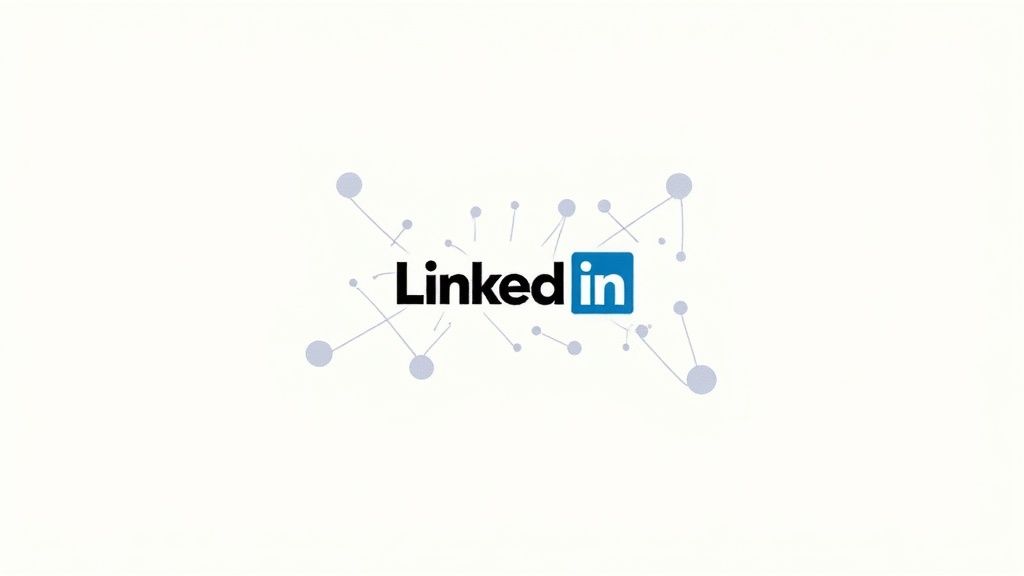
LinkedIn Content Strategy: Boost Business Growth
The Real Landscape of LinkedIn Content Today

LinkedIn has become the premier platform for professionals to connect and consume content. It's a hub for sharing industry knowledge, building thought leadership, and fostering business connections. But what's the reality of the current LinkedIn content scene? Grasping this is the first step to crafting a successful LinkedIn content strategy.
The Content Creator-Consumer Gap
A key characteristic of the LinkedIn content environment is the notable difference between those creating content and those consuming it. While the platform boasts over a billion members, content creation is dominated by a surprisingly small percentage. Only about 1% of LinkedIn users post content every week. Remarkably, these active users generate an astounding 9 billion impressions weekly.
This imbalance presents a significant advantage for businesses and professionals. By regularly sharing valuable content, you can dramatically enhance your visibility and connect with a large audience hungry for relevant industry information. For more on these statistics, check out Column Content's LinkedIn Statistics.
How LinkedIn Differs from Other Platforms
LinkedIn's user behavior distinguishes it from other social media platforms. It cultivates a professional atmosphere where users actively seek industry updates, career guidance, and business-focused solutions. This emphasis on professional growth shapes unique content consumption habits.
For instance, users are more inclined to engage with longer articles, in-depth analysis, and data-backed insights compared to platforms like Instagram or Twitter.
Why Quality Content Reigns Supreme
This distinct user behavior has major consequences for your LinkedIn content approach. Simply reposting content from other platforms won't suffice. Success on LinkedIn requires a dedicated strategy focused on providing high-quality, professionally relevant material.
What does this mean for your LinkedIn content? It should be:
- Informative: Sharing valuable data and perspectives.
- Engaging: Promoting discussion and interaction.
- Actionable: Offering practical advice and solutions.
- Consistent: Adhering to a regular posting schedule.
Capitalizing on LinkedIn's Unique Ecosystem
Understanding the current LinkedIn content landscape empowers you to refine your content strategy for optimal results. By recognizing the creator-consumer gap, appreciating LinkedIn's distinct user behavior, and prioritizing quality content, you set yourself up for success.
This focused approach enables you to harness LinkedIn's strengths and exploit the opportunities it offers. Rather than employing generic social media tactics, you can construct a targeted LinkedIn content strategy that yields tangible results. This builds the foundation for establishing thought leadership, capturing leads, and reaching your business goals on the platform.
Creating LinkedIn Content That Actually Drives Results

Before you create your next LinkedIn post, think about what you want to achieve. A successful LinkedIn content strategy begins with clear, measurable objectives. These objectives should be directly related to your revenue goals. This isn't about superficial metrics; it’s about getting real business results.
Defining Your LinkedIn Objectives
Start by connecting your LinkedIn goals with your overall business objectives. What are you hoping to accomplish? Do you want to increase brand awareness, generate leads, or drive website traffic? Each objective needs a different content approach. For example, if you’re focused on brand awareness, you might share insightful industry trends. If lead generation is your priority, you might offer gated content.
Understanding Your LinkedIn Audience
Knowing your audience is a critical part of any successful LinkedIn content strategy. Think about your ideal clients. Who are they? What are their pain points? LinkedIn audience research will help you understand what resonates with your target demographic. This goes beyond simple demographics. It involves understanding their professional interests, challenges, and aspirations.
Mapping Content to the Customer Journey
Once you know your audience, you can match content types to specific stages of their customer journey. For example, in the awareness stage, focus on educational content to establish your expertise. As prospects move to the consideration stage, offer more detailed resources like case studies and white papers. In the decision stage, use product demos and testimonials to encourage conversions. You might be interested in: 7 Types of Content to Boost Your Presence on LinkedIn.
Balancing Thought Leadership and Lead Generation
The best LinkedIn content strategies find a balance between thought leadership and lead generation. Building your expertise is important. But don't be afraid to include calls to action that guide your audience toward specific outcomes. A subtle call to action within a thoughtful post can be very effective without being overly promotional.
Measuring Success Beyond Vanity Metrics
Finally, look beyond likes and comments to measure your success. Track metrics that directly affect your bottom line, such as website traffic, lead generation, and conversion rates. This data-driven approach lets you adjust your LinkedIn content strategy over time and maximize your return on investment. By analyzing your results, you can identify what's working and what isn't. This allows for continuous improvement and better alignment with your business goals.
Content Formats That Win the LinkedIn Algorithm Game

On LinkedIn, not all content is equal. While high-quality visuals are important, they don't guarantee engagement. A successful LinkedIn content strategy hinges on understanding what content formats both your audience and the algorithm prefer. This means analyzing how different formats, such as text posts, articles, videos, and documents, perform.
Decoding the Algorithm's Preferences
Like all social media algorithms, LinkedIn's algorithm has its quirks. It favors content that encourages users to stay on the platform and interact. This means understanding not only what to post, but how to post it. For example, native videos and images often outperform external links because they keep users within the LinkedIn ecosystem. Content that sparks conversation, like polls and questions, tends to see increased visibility.
Content sharing and engagement on LinkedIn have grown significantly. 96% of B2B content marketers use LinkedIn for content distribution, demonstrating its importance in professional marketing. The engagement rate on LinkedIn has seen a 44% year-over-year increase, indicating the platform's growing user interaction. More detailed statistics can be found here. These stats emphasize the need for a strong LinkedIn content strategy.
The Power of Diversification (Without Spreading Yourself Too Thin)
A diverse content mix is essential to reach different audience segments and keep your content fresh. However, this doesn’t mean creating every type of content imaginable. Focus on a few key formats that align with your business goals and resonate with your target audience. Repurposing content across formats is also a smart strategy. For example, a blog post can become a series of short text posts, a carousel post, or even a short video. For inspiration, check out these Top LinkedIn Carousel Post Examples for 2025.
Leveraging Emerging Formats: LinkedIn Live
Staying ahead of the curve means experimenting with new formats. LinkedIn Live, for example, offers a powerful way to engage with your audience in real-time. Live video can be used for Q&A sessions, product demos, or behind-the-scenes looks at your company culture. This direct interaction strengthens relationships and builds community around your brand.
Choosing the Right Format for the Right Job
Each content format serves a different purpose. Text posts are excellent for quick updates and starting discussions. Articles are ideal for in-depth analysis and thought leadership. Videos are perfect for showcasing your personality, explaining complex ideas, and offering tutorials. Documents, such as white papers and case studies, are valuable resources for lead generation. Understanding the strengths of each format helps tailor your content to specific business objectives.
The following table provides a comparison of different LinkedIn content formats:
LinkedIn Content Format Performance Comparison
This table compares different LinkedIn content formats based on engagement rates, reach potential, and optimal use cases.
| Content Format | Average Engagement Rate | Best For | Production Effort | Algorithm Preference |
|---|---|---|---|---|
| Text Posts | Varies widely | Quick updates, discussions | Low | Moderate |
| Articles | Moderate | In-depth analysis, thought leadership | High | High |
| Images/Infographics | High | Visual storytelling, data presentation | Moderate | High |
| Videos | Very High | Demonstrations, tutorials, behind-the-scenes | High | Very High |
| Documents | Moderate | Lead generation, providing valuable resources | High | Moderate |
| LinkedIn Live | High | Real-time interaction, Q&A sessions | Moderate to High | High |
This table summarizes the strengths and weaknesses of each content format, making it easier to choose the right one for your needs. Videos consistently perform well, but require more effort to produce. Text posts are easy to create, but engagement can vary significantly.
By strategically using different formats and optimizing your LinkedIn content strategy, you can dramatically increase your visibility and engagement, ultimately maximizing your business impact on the platform. This requires consistently analyzing results and adapting your approach based on what works best for your audience and the evolving LinkedIn algorithm.
Building a Sustainable LinkedIn Content System

Consistency is key to a successful LinkedIn content strategy. But posting regularly while maintaining quality can be challenging, even for seasoned marketers. This section explores practical ways to build a sustainable content system that delivers value without leading to burnout.
Developing a Resilient LinkedIn Content Calendar
A well-structured content calendar is essential for any sustainable LinkedIn strategy. It acts as a roadmap for your content, ensuring a consistent flow of valuable posts. This involves planning topics in advance and scheduling posts to maintain a regular presence. A content calendar also offers flexibility, allowing you to adapt to trending topics and industry news.
Establishing a Realistic Posting Cadence
While consistency matters, finding a sustainable posting frequency is equally important. Consider your resources and team capacity. Don’t overcommit to daily posting if it compromises quality or overworks your team.
Start with a realistic frequency, like two or three times a week. You can gradually increase this as your resources allow. For instance, brands on LinkedIn are increasing their posting frequency, now averaging around 18 posts per month to maintain consistent engagement. This is a 10% increase compared to last year. Companies posting weekly see double the engagement compared to less frequent posters. Find more detailed statistics here.
Leveraging Content Batching Techniques
Content batching is a highly effective technique for maximizing efficiency. It involves creating multiple pieces of content in one focused session. This streamlines the creation process and ensures a steady stream of content.
For example, dedicate one day a week to crafting several LinkedIn posts at once. Then schedule them throughout the week. This organized approach maintains consistency without requiring daily content creation.
Balancing Evergreen and Timely Content
A successful LinkedIn content strategy combines evergreen content with timely updates. Evergreen content, like industry insights and how-to guides, remains relevant over time. Timely content, on the other hand, addresses current events and trends, keeping your audience engaged with fresh perspectives. This balance ensures a continuous flow of valuable information while leveraging current discussions.
Streamlining Content Management With Tools
Several tools can simplify LinkedIn content management. Scheduling tools like Buffer allow you to pre-schedule posts, freeing up time for other tasks. Content curation platforms help you discover and share relevant industry content. Analytics dashboards, offered by platforms like Hootsuite, track content performance, providing valuable insights for optimization. These tools streamline workflows and optimize your overall content strategy.
Integrating Employee Advocacy
Employee advocacy can greatly amplify your LinkedIn content’s reach. Encourage your team to share company posts and contribute their own insights. This expands your brand’s visibility and builds a stronger community. Provide employees with guidelines and resources to ensure consistent messaging and quality.
Optimizing Posting Times
While consistent posting is crucial, timing also plays a role in maximizing visibility. Analyze your LinkedIn analytics to understand when your audience is most active. Schedule posts accordingly to reach the largest possible audience. Also, keep up-to-date on algorithm changes that may impact optimal posting times.
By implementing these strategies, you can build a sustainable LinkedIn content system that drives results without overwhelming your team. This approach enables you to consistently deliver quality content, establishing your brand as a valuable resource in your industry.
Turning LinkedIn Engagement Into Business Growth
Moving beyond vanity metrics like likes and comments is crucial for a successful LinkedIn content strategy. The focus should be on creating content that delivers measurable results for your business. This section explores how successful companies are turning LinkedIn engagement into tangible business growth.
Crafting Compelling Calls to Action
Driving conversions requires clear and compelling calls to action. However, these calls to action must feel natural within your content, not forced or overly promotional. Instead of a generic "Click here," try something like "Download our free guide for more information." This adds context and value, making the call to action more appealing.
Designing Effective Content Journeys
Think of your LinkedIn content as a journey for your audience. Each post should guide them further down the sales funnel. This means mapping content to specific stages of the customer journey. For example, top-of-funnel content might build awareness, while bottom-of-funnel content focuses on product demos and testimonials. This structured approach nurtures relationships and moves prospects closer to conversion.
Balancing Thought Leadership and Promotion
Balancing thought leadership and promotional content is essential for audience trust. Showcasing expertise is important, but constant product promotion can alienate followers. Prioritize valuable, non-promotional content, occasionally incorporating subtle calls to action that align with audience needs. This builds credibility and authenticity.
Attributing Business Results to LinkedIn Efforts
Measuring the true ROI of your LinkedIn content strategy requires tracking more than just engagement. You need to directly attribute business results to your LinkedIn activities. This involves tracking website traffic, lead generation, and conversions. This data-driven approach refines your strategy and demonstrates the value of your LinkedIn efforts. This is especially crucial in B2B marketing, where demonstrating ROI is key. LinkedIn is a powerhouse for B2B marketers, with 96% using the platform for content distribution as of early 2025. The platform excels at lead generation, with marketing efforts yielding twice the conversion rates of other channels. 40% of B2B marketers rank LinkedIn as the most effective platform for high-quality leads. Learn more about these statistics here.
Integrating LinkedIn with Your Broader Marketing Funnel
A successful LinkedIn strategy integrates seamlessly with your overall marketing funnel. This means using LinkedIn to drive website traffic, capture leads, and nurture prospects. For example, use gated content on LinkedIn to capture leads, then nurture them through email campaigns. This integrated approach maximizes the impact of your LinkedIn efforts and ensures a consistent brand experience.
Leveraging LinkedIn Analytics for Optimization
LinkedIn Analytics provides valuable data for optimizing your content strategy. Analyzing metrics like post views, engagement rates, and follower demographics provides insights into what resonates with your audience. This data helps refine your content calendar, adjust posting frequency, and tailor your messaging. Continuous optimization is crucial for maximizing your LinkedIn ROI.
Transforming Connections into Clients
The ultimate goal of any LinkedIn content strategy is to turn connections into clients. This involves actively engaging with your audience, responding to comments, and building genuine relationships. By fostering community and providing value, you can transform LinkedIn connections into loyal customers. This requires shifting from broadcasting to facilitating meaningful interactions. This approach builds trust and positions your brand as a valuable resource, driving business growth.
Measuring the ROI of Your LinkedIn Content
Tracking relevant metrics is essential for assessing the success of your LinkedIn strategy. The following table outlines key performance indicators and how they contribute to business impact.
LinkedIn Content ROI Metrics This table outlines key performance indicators to track when measuring the business impact of your LinkedIn content strategy.
| Metric Category | Key Metrics | Measurement Tools | Business Impact |
|---|---|---|---|
| Engagement | Likes, Comments, Shares, Click-Through Rate | LinkedIn Analytics | Indicates audience interest and reach |
| Reach | Impressions, Follower Growth | LinkedIn Analytics | Shows brand visibility and awareness |
| Lead Generation | Lead Form Submissions, Website Clicks | LinkedIn Analytics, CRM | Measures potential customer acquisition |
| Website Traffic | Referral Traffic from LinkedIn | Google Analytics | Demonstrates LinkedIn's contribution to website visits |
| Conversions | Sales, Sign-ups, Downloads | CRM, Website Analytics | Reflects the impact on business goals |
This table highlights the importance of tracking metrics directly tied to your business objectives. By consistently monitoring these KPIs, you gain valuable insights and make data-driven adjustments to maximize your ROI.
Unlocking Employee Advocacy on LinkedIn
Your employees represent a potent force for boosting your LinkedIn content strategy. They bring authentic viewpoints and expand your brand's visibility within their own networks. This section explores building an employee advocacy program that mutually benefits your company and your team.
Identifying and Supporting Content Champions
Begin by identifying employees already active and engaged on LinkedIn. These individuals are your potential content champions. They grasp the platform and possess a genuine passion for your brand. Provide them with extra support and resources to amplify their efforts.
For example, offer training on LinkedIn best practices or grant them early access to company news. This targeted support empowers your champions to effectively represent your brand online.
Empowering Employees With Enablement Resources
Make participation easy by providing resources that simplify content sharing. This could include pre-written posts, engaging visuals, and a clear content calendar. Lumeo can help transform existing content into eye-catching LinkedIn carousels, making it easier for employees to share engaging material.
This removes the burden of content creation from scratch, significantly encouraging greater participation across the team.
Balancing Corporate Messaging and Authenticity
A crucial aspect of successful employee advocacy is balancing consistent brand messaging with the authentic personal voices of your team. Provide guidelines for content sharing, but allow employees to personalize their posts.
This ensures content aligns with your brand identity while resonating authentically within individual networks. Think of corporate messaging as the base, with employee perspectives adding the unique personal touch.
Training and Recognition
Invest in training to equip your employees with effective LinkedIn engagement strategies. This could include workshops on content creation, networking best practices, and understanding LinkedIn's algorithm.
Additionally, implement a recognition system to acknowledge and reward employees actively participating in the advocacy program. This can be simple, such as featuring top contributors in a company newsletter or offering small incentives. Recognizing contributions reinforces positive behavior and sustains motivation.
Scaling and Addressing Challenges
Scaling employee advocacy across larger organizations demands a structured approach. Consider dedicated software platforms to streamline content distribution and monitor participation.
Common challenges such as inconsistent posting and content quality control can be addressed through regular communication, clear guidelines, and ongoing training. This maintains the effectiveness of your program and its alignment with your overall LinkedIn content strategy. For example, establish a review process for employee-generated content to uphold quality and consistency with brand guidelines.
Measuring What Matters in Your LinkedIn Strategy
A successful LinkedIn content strategy requires constant refinement based on performance data. However, not all data holds the same value. This section explores measuring metrics that genuinely matter, moving past vanity metrics and focusing on those aligned with business outcomes.
Identifying Key Performance Indicators
Different goals require different Key Performance Indicators (KPIs). If your goal is brand awareness, track metrics like impressions and reach. If lead generation is your priority, lead form submissions and website clicks become more crucial. For sales conversions, track metrics like demo requests and closed deals. Tailor your measurements to your specific objectives.
Conducting Content Audits That Inform Future Planning
Regular content audits are vital for optimizing your LinkedIn content strategy. Auditing involves analyzing past performance to understand which content resonated and which didn't. This helps identify successful content formats, topics, and posting times. Use this data to inform future planning, repeating successful strategies and avoiding less effective ones. Learn more in our article about Understanding the 2024 LinkedIn Algorithm.
Testing New Approaches While Maintaining Consistency
Consistency is crucial on LinkedIn, but don't shy away from experimentation. Try different content formats, explore new topics, or adjust your posting schedule. A/B testing is a valuable method to compare the performance of different content variations, allowing data-driven optimization.
Gathering Qualitative Feedback Alongside Quantitative Data
Quantitative data offers valuable insights, but don't ignore qualitative feedback. Engage with your audience in the comments, use polls to gather opinions, and conduct surveys for deeper understanding. Qualitative data contextualizes the numbers, enriching your understanding of audience perspective and allowing for a more comprehensive refinement of your strategy.
Benchmarking Against Competitors (Without Falling into Comparison Traps)
Analyzing competitor LinkedIn activity provides valuable benchmarks. Examine their content formats, posting frequency, and engagement levels. This reveals industry best practices and areas for your own improvement. However, avoid simply copying competitors. Instead, use their performance as a reference point for your unique approach.
Translating Engagement Metrics into Business Value
When reporting to stakeholders, translate engagement metrics into tangible business value. Demonstrate how LinkedIn efforts contribute to lead generation, brand awareness, and revenue growth. Connect your LinkedIn KPIs to overall business objectives. For instance, show how increased website traffic from LinkedIn correlates with a higher number of qualified leads.
Evolving Your Strategy as LinkedIn Changes
LinkedIn's platform and algorithm are constantly changing. Stay informed about updates and adapt your strategy accordingly. This maintains content effectiveness in reaching your audience and achieving goals. For example, LinkedIn's increased emphasis on video may require shifting focus from text posts to video creation. Adaptability is key for LinkedIn success.
Turn your content into engaging LinkedIn carousels with Lumeo. Visit Lumeo to transform static content into dynamic, visually appealing presentations that capture attention and drive results.